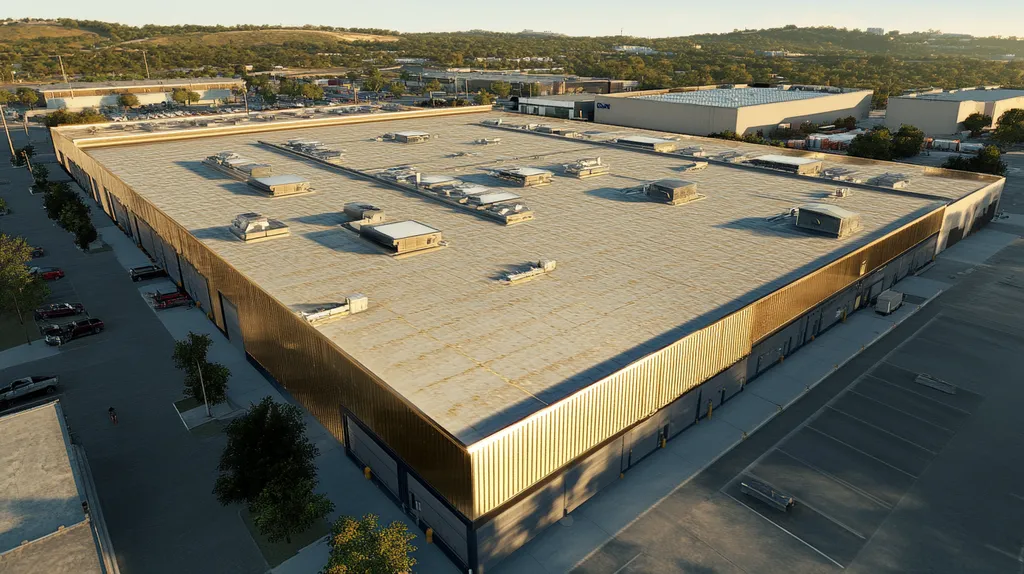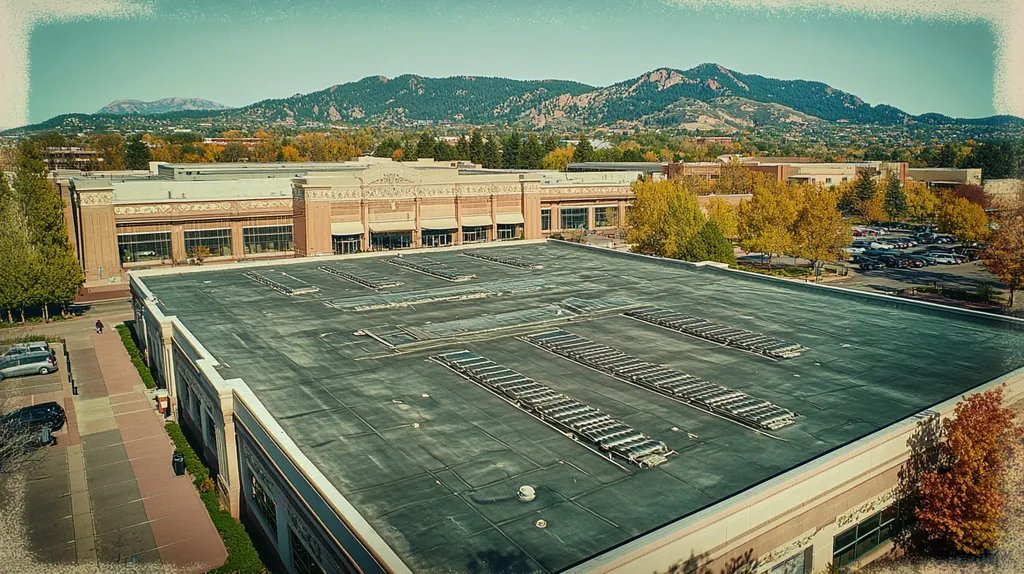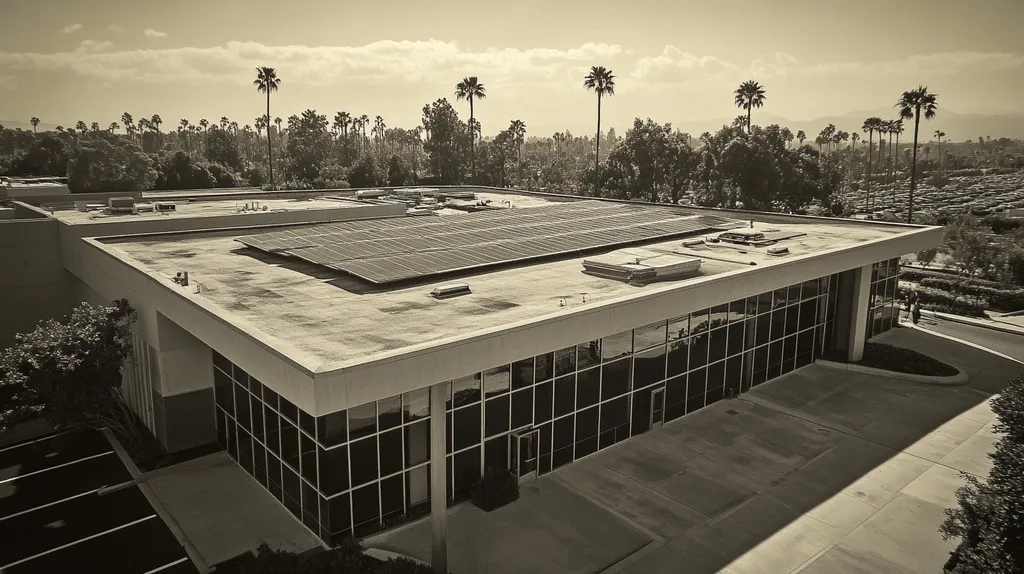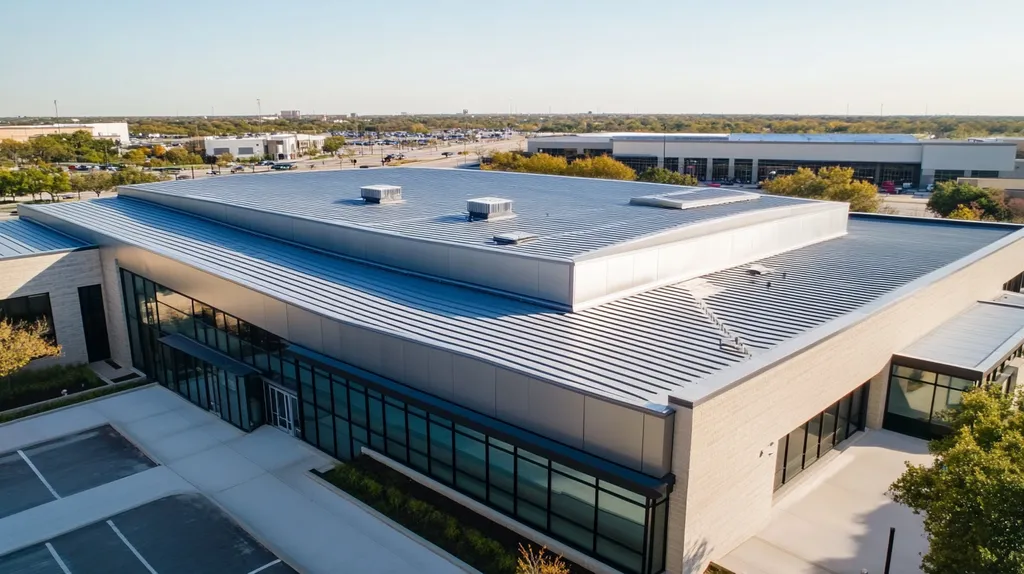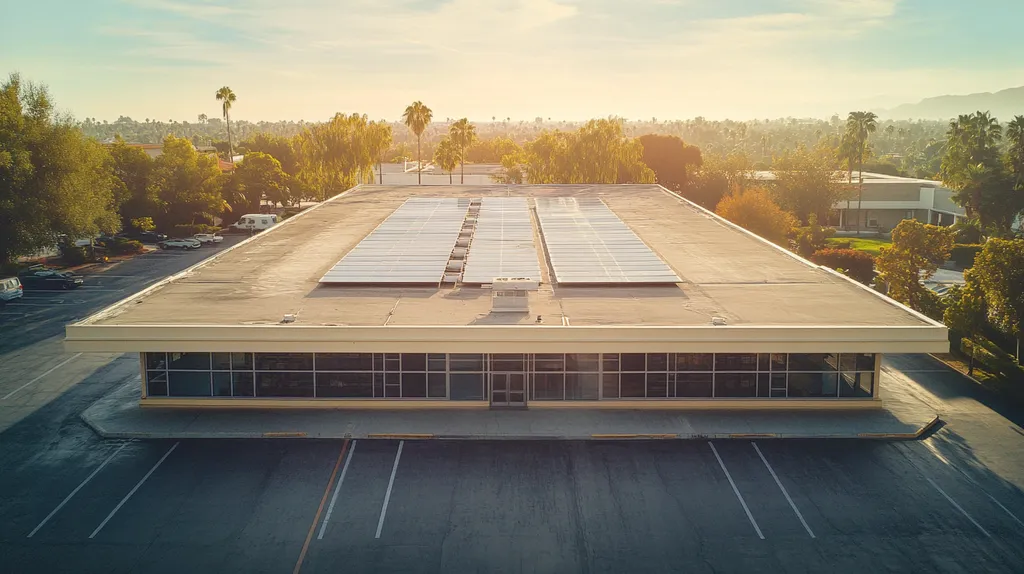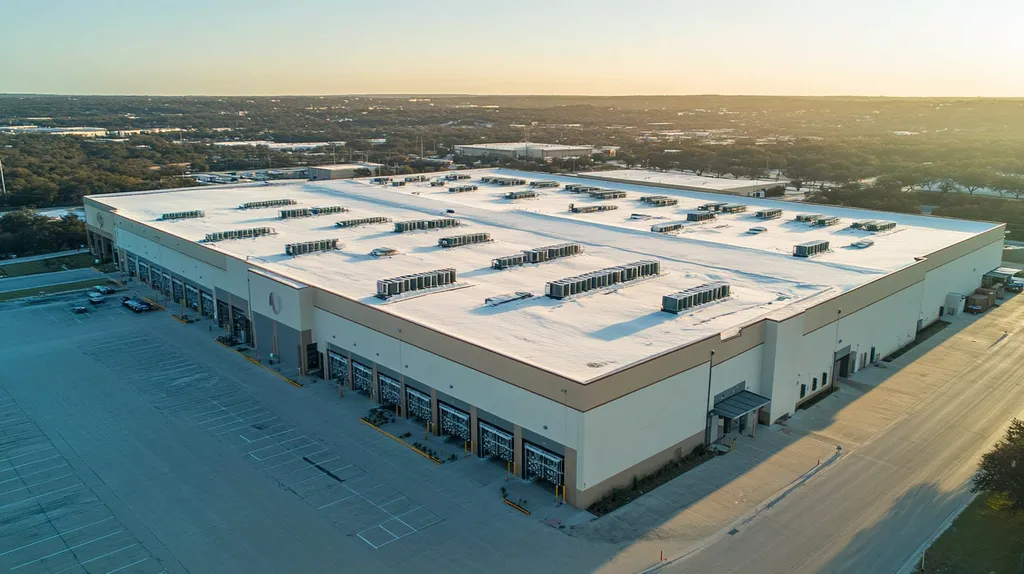Welcome to today’s Battle Royale featuring two roofing heavyweights: “Bank Financing” in the east corner versus “Equipment Leasing” in the west!
Tonight’s showdown pits these contenders against each other across six punishing rounds designed to test every aspect of their performance for New Industrial Roof Financing Options.
At stake? Millions in potential costs, decades of building protection, and the critical performance demands of modern commercial and industrial facilities.
Our professional judging panel will evaluate each round on technical merit, real-world performance, and value delivery. After all six rounds, we’ll declare our ultimate champion.
Ladies and gentlemen, facility managers and building owners… it’s time to rumble!
ROUND 1: INITIAL COSTS & INSTALLATION
When facing a major roofing investment, the initial financial decisions can impact facility operations for decades. Modern industrial roofing projects frequently exceed $500,000, with some installations reaching into the millions. Understanding the true costs and installation requirements becomes critical for protecting both immediate budgets and long-term facility value.
Material Expenses
The material selection process represents the foundation of any successful roofing project. Premium roofing materials typically account for 40-60% of total project costs, making this decision particularly crucial for long-term performance.
Bank financing provides maximum flexibility in material selection, allowing facility managers to choose optimal solutions without compromise. Traditional loans enable investment in advanced materials that offer superior durability and energy efficiency benefits.
Equipment leasing arrangements often restrict material choices to specific suppliers or systems. While these limitations can simplify the selection process, they may prevent access to the most appropriate or cost-effective solutions for specific facility needs.
Bank loans are a common financing choice for large expenses like roof replacements, typically offering fixed interest rates and predictable monthly payments. (source: Northface Construction)
Installation Complexity
Installation requirements vary dramatically based on facility design, existing roof conditions, and local building codes. Complex installations demand experienced contractors and may require specialized equipment or techniques.
Bank financing allows property owners to select contractors based solely on qualifications and experience. This flexibility ensures access to the most capable installation teams, regardless of their financing relationships.
Equipment leasing programs sometimes limit contractor selection to pre-approved installers within their network. While these contractors meet basic requirements, they may lack specialized expertise needed for complex installations.
The ability to choose contractors freely represents a significant advantage for bank financing, particularly for facilities with unique installation challenges.
Project Timeline
Project timing impacts both installation costs and facility operations. Weather windows, material availability, and contractor scheduling all influence completion timelines.
Bank financing typically provides faster access to funds once approved, allowing projects to proceed according to optimal scheduling. This flexibility helps avoid costly delays and ensures installation occurs during favorable conditions.
Equipment leasing often involves additional approval steps and coordination between multiple parties. These extra requirements can extend project timelines and potentially push installation into less favorable seasons.
The streamlined nature of bank financing provides clearer advantages for maintaining critical project schedules.
ROUND 1 WINNER: BANK FINANCING
ROUND 2: DURABILITY & LIFESPAN
When investing in an industrial roof, the durability and lifespan decisions made today can impact facility operations for decades. Modern roofing systems represent significant capital investments, often exceeding $1 million for large facilities. Understanding how financing choices affect long-term performance becomes critical for protecting both immediate budgets and future operational stability.
Material Durability
Material selection directly influences a roof’s performance and longevity. Premium industrial roofing materials can provide 20-30 years of reliable service, while lower-quality alternatives may require replacement in less than a decade.
Bank financing encourages investment in superior materials by offering longer repayment terms that align with expected roof lifespans. This alignment allows facility managers to select materials based on performance rather than initial cost.
Equipment leasing programs frequently promote specific material packages that may prioritize short-term affordability over long-term durability. While these packages can reduce upfront costs, they may compromise overall system longevity.
Bank financing demonstrates a clear ADVANTAGE in supporting durable material choices.
Maintenance Requirements
Regular maintenance significantly impacts roof longevity and performance. Professional inspections, preventive repairs, and proper upkeep can extend a roof’s useful life by 25% or more.
Bank financing structures typically allow facility managers to establish comprehensive maintenance programs. This flexibility enables proper budgeting for ongoing care and immediate attention to emerging issues.
Equipment leasing packages may include basic maintenance provisions but often restrict service providers and scope. These limitations can prevent optimal care and lead to accelerated deterioration.
For maintenance considerations, bank financing shows an ADVANTAGE through greater flexibility and control.
Return on Investment (ROI)
A roof’s ROI depends heavily on its sustained performance over time. Premium roofing systems that maintain their integrity deliver superior value through reduced repair costs and extended replacement intervals.
Bank financing supports strategic ROI planning by offering favorable terms and longer repayment periods that match roof lifespans. Loans enable investment in systems that maximize long-term value while maintaining reasonable monthly payments. (source: Rainville Carlson)
Equipment leasing often creates higher total costs over time through ongoing lease payments and potential replacement needs. While monthly payments may be lower initially, the cumulative expense typically exceeds traditional financing options.
The ROI analysis reveals another clear ADVANTAGE for bank financing.
ROUND 2 WINNER: BANK FINANCING
ROUND 3: PERFORMANCE FACTORS
Performance factors can make or break an industrial roofing investment, directly impacting facility operations and maintenance costs for decades. Modern roofing systems must deliver consistent protection while managing energy costs and minimizing disruptions. Understanding how financing choices affect these crucial performance metrics helps facility managers avoid costly mistakes.
Material Quality
Material quality serves as the foundation for long-term roof performance. Premium materials resist weathering, maintain structural integrity, and provide reliable protection against the elements. The choice of materials directly impacts maintenance frequency and repair costs.
Bank financing enables facility managers to select optimal materials based on performance requirements rather than cost constraints. This flexibility allows investment in advanced membrane systems, superior insulation, and enhanced protective coatings that maximize system longevity.
Equipment leasing programs often limit material selection to pre-approved options that may not represent the best performance value. While these materials meet basic requirements, they may lack the durability and resilience needed for challenging industrial environments.
For material quality considerations, bank financing demonstrates a clear ADVANTAGE through greater selection flexibility and access to premium options. (source: The Trinity Way)
System Integration
Modern industrial roofs must integrate effectively with HVAC systems, solar installations, and other rooftop equipment. Poor integration leads to increased energy costs and potential system conflicts that compromise overall performance.
Bank financing allows facility managers to coordinate comprehensive system integration during installation. This approach ensures all rooftop components work together efficiently while maintaining warranty coverage.
Equipment leasing can restrict modification options and limit integration possibilities. These constraints may prevent optimal system coordination and reduce overall facility performance.
The system integration category shows another ADVANTAGE for bank financing through enhanced flexibility and customization options.
Performance Monitoring
Effective performance monitoring helps identify and address issues before they escalate into major problems. Regular inspections and testing ensure the roofing system maintains its protective and efficiency capabilities throughout its service life.
Bank financing enables implementation of sophisticated monitoring systems and regular assessment programs. This proactive approach helps maintain optimal performance while preventing unexpected failures.
Equipment leasing packages may include basic monitoring but often lack comprehensive oversight capabilities. These limitations can leave performance issues undetected until significant damage occurs.
For performance monitoring capabilities, bank financing takes the ADVANTAGE through superior control and assessment options.
ROUND 3 WINNER: BANK FINANCING
ROUND 4: MAINTENANCE REQUIREMENTS
Maintenance decisions made during roof financing can impact facility operations for decades to come. Industrial roofing systems require consistent care to maintain their protective capabilities and energy efficiency. With maintenance costs often reaching $50,000 annually for large facilities, understanding how financing choices affect ongoing care becomes critical for protecting both immediate budgets and long-term asset value.
Scheduled Maintenance
Regular maintenance inspections and preventive care represent fundamental requirements for maintaining roof performance and warranty coverage. Professional assessments typically occur quarterly, with more intensive evaluations scheduled annually to identify developing issues before they escalate.
Bank financing provides flexibility in selecting maintenance providers and establishing customized care schedules. This autonomy enables facility managers to adapt maintenance programs as facility needs evolve, ensuring optimal system protection.
Equipment leasing packages frequently include predetermined maintenance schedules with specific service providers. While these arrangements simplify planning, they may not align perfectly with facility-specific requirements or operational schedules.
For scheduled maintenance considerations, bank financing shows an ADVANTAGE through greater control and customization options.
Emergency Repairs
Unexpected damage from severe weather or equipment failures demands swift response to prevent facility disruptions. Emergency repair costs can quickly escalate when service provider options are limited or approval processes delay critical work.
Bank financing allows immediate engagement with any qualified repair service, enabling rapid response to emergencies. This flexibility proves particularly valuable during severe weather events when contractor availability becomes limited.
Equipment leasing often requires coordination through approved service providers for emergency repairs. While these providers maintain basic response capabilities, their availability or specialized expertise may not match facility needs during critical situations.
Emergency repair considerations reveal another ADVANTAGE for bank financing through superior response flexibility.
Long-term Care
Comprehensive roof maintenance involves more than just routine inspections and emergency repairs. Energy efficiency monitoring, drainage system maintenance, and preventive treatments all contribute to optimal performance and extended service life.
Bank financing enables facility managers to implement evolving maintenance technologies and procedures as they become available. This adaptability helps maintain peak system performance while potentially reducing long-term care costs.
Equipment leasing packages typically include standardized long-term care provisions that may not incorporate the latest maintenance innovations. These fixed arrangements can limit opportunities for optimizing care procedures or adopting cost-saving technologies.
The long-term care category demonstrates an ADVANTAGE for bank financing through greater adaptability and innovation potential.
ROUND 4 WINNER: BANK FINANCING
ROUND 5: SUSTAINABILITY CREDENTIALS
Sustainable roofing has become a critical factor in modern industrial facility management. With energy costs soaring and environmental regulations tightening, choosing eco-friendly roofing solutions can reduce operational expenses by 20-30% annually while meeting growing sustainability mandates. The financing approach selected can significantly impact a facility’s ability to implement green roofing technologies effectively.
Sustainable Material Selection
Modern sustainable roofing materials offer remarkable environmental benefits while delivering superior performance. Cool roofs, recycled membranes, and green roofing systems can reduce energy consumption by up to 50% compared to traditional materials.
Bank financing enables facility managers to select optimal sustainable materials without compromise. This flexibility allows investment in advanced green technologies that may have higher upfront costs but deliver significant long-term environmental and financial benefits.
Equipment leasing typically restricts material choices to specific pre-approved options. While these may include some sustainable alternatives, the limited selection often prevents access to the most innovative or effective green roofing solutions.
For sustainable material selection, bank financing shows a clear ADVANTAGE through greater access to cutting-edge green technologies.
Energy Performance Standards
Energy performance standards for industrial roofing continue to evolve rapidly. Current requirements often mandate specific efficiency levels and environmental impact metrics that directly affect operational costs.
Bank financing supports comprehensive energy performance planning by allowing investment in advanced monitoring systems and efficiency technologies. This approach enables facilities to meet or exceed current standards while preparing for future requirements.
Equipment leasing packages frequently focus on meeting minimum energy standards rather than optimizing performance. These limitations can prevent facilities from achieving maximum efficiency potential.
The energy performance category reveals another ADVANTAGE for bank financing through superior long-term planning capabilities.
Environmental Certification
Environmental certifications like LEED and Energy Star increasingly influence facility valuations and operational costs. Achieving these certifications requires careful coordination of roofing systems with overall building performance goals.
Bank financing provides the flexibility needed to integrate roofing solutions with broader sustainability initiatives. This comprehensive approach supports achievement of environmental certifications while maximizing potential incentives and benefits.
Equipment leasing can complicate certification efforts by limiting system integration options and modification capabilities. These restrictions may prevent facilities from qualifying for certain environmental certifications or achieving optimal performance levels.
For environmental certification potential, bank financing demonstrates another clear ADVANTAGE.
ROUND 5 WINNER: BANK FINANCING
ROUND 6: SPECIALIZED APPLICATIONS
Specialized industrial roofing applications present unique challenges that demand careful financing consideration. With complex installations often exceeding $2 million and requiring custom solutions, the wrong financing choice can compromise system performance and facility operations for decades. Modern industrial facilities increasingly require sophisticated roofing systems that integrate advanced materials, specialized equipment, and complex monitoring systems.
Custom System Requirements
Industrial facilities frequently require highly specialized roofing solutions to address unique operational challenges. From chemical resistance in manufacturing environments to extreme temperature control in food processing facilities, custom system requirements demand careful material selection and installation planning.
Bank financing provides the flexibility to design and implement truly customized solutions. This approach allows facility managers to select specialized materials, unique system components, and specific installation methods without artificial constraints.
Equipment leasing typically offers standardized system packages that may not fully address specialized facility requirements. While these packages can work for basic applications, they often lack the customization options needed for complex industrial environments.
For custom system requirements, bank financing shows a clear ADVANTAGE through superior flexibility and customization potential.
Technical Integration
Modern industrial roofs must seamlessly integrate with sophisticated facility systems. From advanced climate control to specialized ventilation and safety systems, technical integration requirements continue growing more complex.
Bank financing enables comprehensive technical integration planning and implementation. This flexibility allows facilities to coordinate roofing systems with current equipment while maintaining adaptability for future technological upgrades.
Equipment leasing arrangements often restrict modification capabilities and system integration options. These limitations can prevent optimal coordination between roofing systems and critical facility equipment.
The technical integration category reveals another ADVANTAGE for bank financing through enhanced coordination capabilities.
Application-Specific Solutions
Different industrial applications demand distinct roofing solutions based on operational requirements and environmental conditions. Specialized applications may require unique combinations of materials, installation techniques, and monitoring systems to ensure optimal performance.
Bank financing supports the development and implementation of application-specific solutions. This approach allows facilities to address unique challenges while maintaining long-term flexibility for system modifications.
Equipment leasing programs typically focus on standardized solutions that may not adequately address specialized application requirements. While these solutions can work for general applications, they often fall short for facilities with unique operational demands. (source: Rainville-Carlson)
For application-specific considerations, bank financing demonstrates another clear ADVANTAGE.
ROUND 6 WINNER: BANK FINANCING
AND THE WINNER IS…
After six punishing rounds of technical evaluation, we have our verdict, ladies and gentlemen! In a decisive victory, scoring a perfect 6-0 sweep across all categories, BANK FINANCING has claimed the championship belt!
Bank financing dominated this matchup through superior flexibility, delivering knockout performances in critical areas like material selection, maintenance options, and specialized applications. Its ability to adapt to unique facility requirements while supporting long-term sustainability goals proved unstoppable.
But don’t count equipment leasing completely out of the fight! For facilities needing simplified approval processes or dealing with strict capital expenditure limitations, this contender can still deliver a solid performance.
*Important Championship Rules Notice*
Every facility enters the ring with unique requirements that can impact financing outcomes. Local conditions, building characteristics, and specific operational demands all play crucial roles in determining the optimal approach. This analysis provides general guidance but cannot account for all variables. Property owners should consult qualified professionals who can evaluate their specific situation before making any financing decisions.
Remember, champions: in the high-stakes arena of industrial roofing, victory goes to those who carefully match their facility’s specific requirements with the right financing contender’s strengths. Now get out there and make your roofing decisions count!
FREQUENTLY ASKED QUESTIONS
Q. What are the initial costs for commercial roof financing?
A. Initial costs for a commercial roof could be significant, often exceeding $500,000. It’s vital to understand all expenses, including material and installation, to ensure budget compliance.
Q. How does durability affect an industrial roof’s lifespan?
A. Durability is crucial, as premium materials can extend the roof’s lifespan to 20-30 years. Choosing quality materials directly impacts maintenance needs and long-term costs.
Q. What performance factors should I consider for my industrial roof?
A. Essential performance factors include material quality and system integration. Ensuring your roof effectively integrates with other building systems can prevent energy inefficiencies and costly repairs.
Q. How can maintenance requirements influence commercial roofing financing?
A. Maintenance planning is crucial as it impacts long-term roof performance. Choosing financing that allows for flexible maintenance schedules can help prolong the roof’s lifespan and protect investments.
Q. Why should I prioritize sustainability in my industrial roof financing?
A. Sustainable roofing solutions can significantly reduce operational expenses. Prioritizing eco-friendly options may also help meet regulations and enhance building value while minimizing environmental impact.
Q. What are specialized applications for industrial roofs?
A. Specialized applications include environments needing unique materials, such as chemical resistance or temperature control. Custom financing options allow for tailored solutions that meet specific operational requirements.
Q. How do financing options affect long-term roof value?
A. Financing options can influence long-term value by affecting material quality and maintenance capabilities. Choosing the right financing ensures you can invest in materials and practices that extend roof life.

